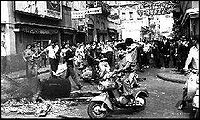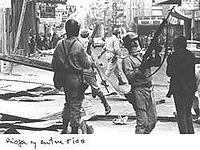
Rosariazo
Encyclopedia


Protest
A protest is an expression of objection, by words or by actions, to particular events, policies or situations. Protests can take many different forms, from individual statements to mass demonstrations...
movement that consisted in demonstrations
Demonstration (people)
A demonstration or street protest is action by a mass group or collection of groups of people in favor of a political or other cause; it normally consists of walking in a mass march formation and either beginning with or meeting at a designated endpoint, or rally, to hear speakers.Actions such as...
and strike
Strike action
Strike action, also called labour strike, on strike, greve , or simply strike, is a work stoppage caused by the mass refusal of employees to work. A strike usually takes place in response to employee grievances. Strikes became important during the industrial revolution, when mass labour became...
s, in Rosario
Rosario
Rosario is the largest city in the province of Santa Fe, Argentina. It is located northwest of Buenos Aires, on the western shore of the Paraná River and has 1,159,004 residents as of the ....
, , between May and September 1969, during the military dictatorial
Dictatorship
A dictatorship is defined as an autocratic form of government in which the government is ruled by an individual, the dictator. It has three possible meanings:...
rule of de facto President
President of Argentina
The President of the Argentine Nation , usually known as the President of Argentina, is the head of state of Argentina. Under the national Constitution, the President is also the chief executive of the federal government and Commander-in-Chief of the armed forces.Through Argentine history, the...
General Juan Carlos Onganía
Juan Carlos Onganía
Juan Carlos Onganía Carballo was de facto president of Argentina from 29 June 1966 to 8 June 1970. He rose to power as military dictator after toppling, in a coup d’état self-named Revolución Argentina , the democratically elected president Arturo Illia .-Economic and social...
. The Rosariazo was caused by events in other parts of Argentina, and in turn triggered similar protests itself.
There was a general climate of unrest caused by social injustice in the country. On 13 May 1969, in Tucumán, former workers of a sugar
Sugar
Sugar is a class of edible crystalline carbohydrates, mainly sucrose, lactose, and fructose, characterized by a sweet flavor.Sucrose in its refined form primarily comes from sugar cane and sugar beet...
mill took the factory and its manager as hostage, asking for overdue payments. On 14 May, in Córdoba
Córdoba, Argentina
Córdoba is a city located near the geographical center of Argentina, in the foothills of the Sierras Chicas on the Suquía River, about northwest of Buenos Aires. It is the capital of Córdoba Province. Córdoba is the second-largest city in Argentina after the federal capital Buenos Aires, with...
, automobile industry workers protested the elimination of the Saturday rest. On 15 May the University of Corrientes
Corrientes
Corrientes is the capital city of the province of Corrientes, Argentina, located on the eastern shore of the Paraná River, about from Buenos Aires and from Posadas, on National Route 12...
increased the price of food tickets in its cafeteria fivefold, and the ensuing protest ended up with one student, Juan José Cabral, killed by the police.
First Rosariazo

Rector
The word rector has a number of different meanings; it is widely used to refer to an academic, religious or political administrator...
suspended university activities until next Monday. The next day a protest started at the cafeteria of the UNR. The police suffocated a demonstration and killed student Adolfo Bello. The CGT labour union called for an "status of alert", and Bello's murder was denounced by the public.
On 20 May, the students of Rosario announced a national strike (similar protests took place in other provinces). On 21 May, university student groups and secondary school students, along with the CGT, organized a silent march, which gathered 4,000 people. The police sent to suffocate the protest had to retreat, but killed the 15-year-old student Luis Blanco. This was later known as the first Rosariazo. From that evening the city was declared an emergency zone under military jurisdiction. A massive worker strike was declared on 23 May in Rosario
Rosario
Rosario is the largest city in the province of Santa Fe, Argentina. It is located northwest of Buenos Aires, on the western shore of the Paraná River and has 1,159,004 residents as of the ....
and the nearby Industrial Corridor. Blanco's funeral was attended by more than 7,000 people.
On 29 May there was a general strike in the city of Córdoba, which brought police repression and a civil uprising
Rebellion
Rebellion, uprising or insurrection, is a refusal of obedience or order. It may, therefore, be seen as encompassing a range of behaviors aimed at destroying or replacing an established authority such as a government or a head of state...
, an episode later termed the Cordobazo
Cordobazo
The Cordobazo was a civil uprising in the city of Córdoba, Argentina, in the end of May 1969, during the military dictatorship of General Juan Carlos Onganía, which occurred a few days after the Rosariazo, and a year after the French May '68...
. The next day the CGT called for national strike.
The May Revolution
May Revolution
The May Revolution was a week-long series of events that took place from May 18 to 25, 1810, in Buenos Aires, capital of the Viceroyalty of the Río de la Plata, a Spanish colony that included roughly the territories of present-day Argentina, Bolivia, Paraguay and Uruguay...
commemoration on 25 May was marked by the refusal of many priest
Priest
A priest is a person authorized to perform the sacred rites of a religion, especially as a mediatory agent between humans and deities. They also have the authority or power to administer religious rites; in particular, rites of sacrifice to, and propitiation of, a deity or deities...
s to celebrate the traditional Te Deum
Te Deum
The Te Deum is an early Christian hymn of praise. The title is taken from its opening Latin words, Te Deum laudamus, rendered literally as "Thee, O God, we praise"....
in Rosario and nearby towns. In the celebration of the National Flag Day (20 June), President Onganía customarily visited Rosario and was declared persona non grata
Persona non grata
Persona non grata , literally meaning "an unwelcome person", is a legal term used in diplomacy that indicates a proscription against a person entering the country...
.
Second Rosariazo
After a few months of relative calm, Rosario university students started a series of protests and homages commemorating the victims of state repression on 7 September 1969.Upon the suspension of a railroad labour union deputy, Mario Horat, the railroad workers of Rosario went on strike on 8 September; on 12 September the union declared a nationwide indefinite strike. The government enlisted the military for repression. Several factories were occupied in Córdoba, and there was a massive uprising in Cipolletti
Cipolletti
Cipolletti is a city in north of the Patagonian , with 75,078 inhabitants as of the .The city is located on the north-eastern shore of the Neuquén River, just before it is joined by the Limay River to form the Negro River, a short distance upstream from the city of General Roca...
, Río Negro
Río Negro Province
Río Negro is a province of Argentina, located at the northern edge of Patagonia. Neighboring provinces are from the south clockwise Chubut, Neuquén, Mendoza, La Pampa and Buenos Aires. To the east lies the Atlantic Ocean.Its capital is Viedma...
.
On 15 September the CGT of Rosario declared a strike, and on the morning of the next day the workers marched on the city. Fight and repression filled the city; estimates vary between 100 and 250 thousand took part in the protests, which were termed the Second Rosariazo (or Proletarian Rosariazo). The workers converged on the seat of the CGT and were joined by students, who had previously gathered at the faculties.

Barricade
Barricade, from the French barrique , is any object or structure that creates a barrier or obstacle to control, block passage or force the flow of traffic in the desired direction...
s and re-grouped in many different points. Public transport units were set on fire. Police control was reduced to some important buildings such as the Command Seat of the Second Army Corps, the Police Headquarters, the Tribunals and the major radio stations. The conflict spread to the peripheric barrio
Barrio
Barrio is a Spanish word meaning district or neighborhood.-Usage:In its formal usage in English, barrios are generally considered cohesive places, sharing, for example, a church and traditions such as feast days...
s.
In view of the situation, on 17 September the Army took charge. Among the participants of the repression was Colonel Leopoldo Galtieri
Leopoldo Galtieri
Leopoldo Fortunato Galtieri Castelli was an Argentine general and President of Argentina from December 22, 1981 to June 18, 1982, during the last military dictatorship . The death squad Intelligence Battalion 601 directly reported to him...
(who would later become president in 1981). The local head of command ordered the soldiers to fire without warning upon the slightest provocation. From this point on, the fight was lost for the protesters; it ended with hundreds dead or wounded, and many arrested.
The power of President Onganía was weakened by the Rosariazo and the Cordobazo, to the point that the dominant military faction asked him to resign, which he refused to do. He was forced out of office by a military junta on 8 June 1970.
See also
- History of RosarioHistory of RosarioThe history of Rosario began on the XVII century, when the Spanish established a settlement in the zone. Rosario lies by the Paraná River, about 300 km upstream from the Argentine capital Buenos Aires; it is a major port and an industrial, commercial and cultural center...
- History of ArgentinaHistory of ArgentinaThe history of Argentina is divided by historians into four main parts: the pre-Columbian time, or early history , the colonial period , the independence wars and the early post-colonial period of the nation and the history of modern Argentina .The beginning of prehistory in the present territory of...
- CaracazoCaracazoThe Caracazo or sacudón is the name given to the wave of protests, riots and looting and ensuing massacre that occurred on 27 February 1989 in the Venezuelan capital Caracas and surrounding towns. The riots — the worst in Venezuelan history — resulted in a death toll of anywhere between...
- CordobazoCordobazoThe Cordobazo was a civil uprising in the city of Córdoba, Argentina, in the end of May 1969, during the military dictatorship of General Juan Carlos Onganía, which occurred a few days after the Rosariazo, and a year after the French May '68...
- BogotazoBogotazoEl Bogotazo refers to the massive riots that followed the assassination in Bogotá, Colombia of Liberal leader and presidential candidate Jorge Eliécer Gaitán on April 9, 1948 during the government of President Mariano Ospina Pérez...

